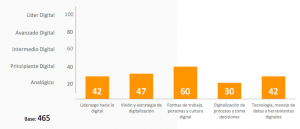Digital transformation is a fact !! It is a reality that has come to settle in our life and in our business.
According to Google Trends, the word #digital transformation has had a continuous increase in Internet searches with an 80-90% increase. There are more than 6 million results in search engines. But do we know what it means? Digital transformation is often confused with digitization
The consulting firm Gartner defines digitization as the “use of digital technologies to change a business model and deliver new opportunities for generating value and income. It is the process of moving towards a digital business ”. Digitization focuses on the implementation of systems and processes that generate inputs for better data-based decision making.
While digital transformation, according to the Santiago Chamber of Commerce (CCS), is a cultural and strategic change, through which companies or organizations are oriented to improve the experience of their customers and / or the creation of new business models , through the incorporation of digital technologies, to offer more efficient, innovative, fast and profitable solutions.
Therefore, digital transformation is based on 5 axes:
- Leadership towards digital: There is and is explicitly identified a first level leader in the organization in charge and with the capacities to promote, coordinate and mobilize the organization towards a process of Digital Transformation.
- Vision and strategy focused on the client: The organization’s explicit objective is to provide an exceptional experience to its clients and to permanently innovate in products, technological solutions or business models that impact it.
- Forms of work, people and digital culture: The organization is flexible and agile, it works collaboratively both internally and with external partners.
- Digitization of processes and decision-making: The company has structured, efficient and digitized processes and clear business rules that allow automated decision-making.
- Technology, data management and digital tools: The company has digital technologies, databases and tools, and takes advantage of them to efficiently offer an exceptional omnichannel experience to its customers.
In this context, the CCS produces an annual report on the Digital Transformation Index (ITD), which measures the level of maturity and evolution in the incorporation of digital tools and practices in companies and SMEs in Chile.
In its 2020 version, it went from a “Beginner” level to a “Digital Intermediate”, since these technologies are playing a fundamental role in helping the productive sector to adapt to the health contingency. However, half of them are still at a “Digital Beginner” level or lower.
Analyzing the 5 dimensions, we see that the axis of least evolution is “Digitization of processes and decision-making”, which requires the enabling of “softer” aspects for its development; while the dimension “Forms of work, people and culture” is the one that presents the highest level of evolution, which indicates that culture allows a greater transformation, but from then on it can be a brake on transformation if it does not evolve at the same time. pair of the other dimensions.

However, the figures show a maturity gap between large companies and SMEs, as 68% of large corporations have an intermediate or higher level of maturity, compared to 55% of SMEs.
There are different approaches regarding the impact of digital transformation in companies, since more than two thirds of large companies declare a relevant achievement of digital transformation in reducing process costs; while SMEs indicate that it has helped them to get new customers.
Regarding the use of technologies, we see that those of wide use (Social Networks, Cloud, Mobile Technologies and Digital Marketing) are used intensively by companies at all levels of digital maturity. Instead, other more sophisticated technologies, such as Big Data, Cybersecurity, and Artificial Intelligence are common among digital leaders, but rare elsewhere.
The sectoral view offers differences, since the Construction sector shows the lowest level of maturity, where six out of ten companies have a “Digital Beginner” level of maturity or less. The level of evolution of the Services and Health sectors stands out, since, in the latter, four out of ten companies are at the “Digital Advanced” level or higher.
From TDDS Chile we work to help SMES to advance continuously in the digital transformation process, through the diagnosis and development of individual plans in companies, as well as in the training of professionals in digital skills.
By: Patricia Miralles



Leave a Reply
Want to join the discussion?Feel free to contribute!